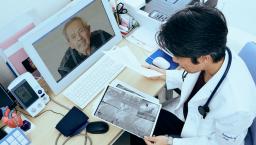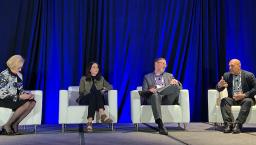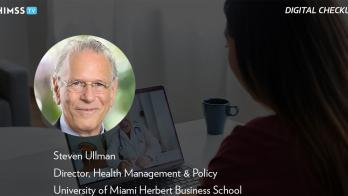At Geisinger, DME ordering automation pays off with big dividends

Photo: Geisinger
Geisinger Health Plan serves more than 600,000 members across the state of Pennsylvania, including rural and underserved populations outside of the larger metropolitan areas.
THE PROBLEM
Many of these members want or need to access healthcare from their homes, whether that looks like a mother who needs a breast pump and support from an in-home lactation consultant or a COPD patient receiving respiratory therapy and oxygen on a daily or weekly basis.
But the infrastructure that exists today to help patients navigate care in their homes is fragmented and challenging.
"We at Geisinger have worked to provide our patients with the best possible at-home care – with top-notch clinical providers, telehealth-enabled communications and innovative care programs – but without that technology layer, we faced our own sets of challenges," said Dr. John Bulger, chief medical officer at Geisinger Health Plan.
"Managing our durable medical equipment network and the more than 1,900 DME providers we work with every day was creating significant administrative burdens and made it challenging to allocate time and resources to managing network visibility on metrics such as quality," he continued. "This resulted in a highly fragmented network, creating an inconsistent provider referral experience and leading to minimal member loyalty."
These supplier challenges created an unpredictable member experience, as well, with the highest volume DME supplier rated 1 out of 5 stars by members.
"We regularly received complaints and grievances from members related to poor service, delivery delays, billing mistakes, unexpected charges or general unresponsiveness," Bulger explained. "Our mission at Geisinger has long been to enhance the quality of life for our patients through health, so it was essential that we improved the home-based care experience for providers, suppliers, and, most importantly, patients."
PROPOSAL
Geisinger ideally was looking for a vendor that could streamline the end-to-end member experience, enable timely and seamless care transitions, and drive both direct and indirect savings for Geisinger.
"Tomorrow Health’s technology platform is improving visibility, increasing quality and reducing cost, all while staying compliant with existing benefits and coverage," Bulger said. "The solution is a foundational home-based care infrastructure platform that can help healthcare organizations like us support home-based care for thousands of patients."
MEETING THE CHALLENGE
What this looks like in practice is essentially the automation of the DME ordering process. Tomorrow Health’s technology integrates into a referring provider’s workflow, prompting them with a multi-step questionnaire based on the items they’re prescribing for home-based care and the complexities of the member’s health plan requirements.
The vendor then sends the order to a medical equipment supplier that is able to more immediately process the order given that more than 80% of the vendor's digital orders have complete documentation, Bulger noted.
"This saves administrative time, reduces operating costs and shortens the time it takes for members to get medical equipment to their homes," he said. "From there, patients, referring providers and payers are kept informed of the prescription’s status – and future care is integrated and automated to allow for a more seamless experience and greater support of patients.
"Launching required no technical integrations and minimal IT resourcing from our Geisinger team," he continued. "The Tomorrow Health platform integrates with our existing EHR for increased usage from providers and seamless flow of work. The vendor also helped establish familiarity with its solution by training our customer service teams, which helped ensure our members were met with support throughout the entire shift in process."
The company also onboarded Geisinger's extensive supplier network, which offered clear guidance and hands-on instruction as they navigated a new system.
RESULTS
"We have seen an incredible, measurable improvement in how we deliver home-based care to Geisinger patients across the state," Bulger reported. "Most notably, we partnered with our actuary team to calculate a 4-times financial return on investment from our work with Tomorrow Health – largely from optimizing our supplier network to drive efficiency, automate manual processes and avoid care delays, which often can result in costly readmissions and preventable repeats in care.
The vendor also helped Geisinger reduce overall turnaround time by 83% since the start of their work.
"The platform’s ease of use not only saves administrative time but gives providers peace of mind that their members are receiving quality equipment and services," he said. "In turn, the platform has helped many of our suppliers improve their order times, with end-to-end order time reduced by six days within the network.
"Most critically for me, we also saw a 95% member satisfaction rate after implementing the solution – which, as our chief medical officer and someone who regularly engages with patients to hear their concerns, was paramount to a successful partnership. Now, many of them tell me they receive their at-home care and equipment significantly earlier than before, and they find the proactive communication and updates comforting during difficult times."
The vendor's care advocate program ensures experts are available to interact with members, answer questions, clarify the status of orders and resolve any issues in the moment, so patients are never left in the dark about their care, he added.
ADVICE FOR OTHERS
"I am a huge believer in the importance of home-based healthcare," Bulger stated. "More than 70% of U.S. adults prefer to receive care at home versus a medical facility following a major medical event – and an estimated $265 billion worth of care services will shift to the home over the next three years for Medicare populations alone.
"We know that, for thousands of our patients, the home is their best option and first choice for care – it allows them to live their lives with flexibility while driving better health outcomes," he continued. "But as an industry, we haven’t optimized the way home-based care is delivered today, and the nuances of this process can present challenges for health systems and payers looking to offer patients care in their homes."
Geisinger has seen the investment in a home-based care vendor pay off in dividends – this technology automates manual processes, keeps communication seamless between all parties, and creates a strong foundation to build and grow the home-based care offering, he added.
"I would encourage other provider organizations and health plans who recognize the challenges of the home-based care system to look at the impact care in the home could have not only on their businesses and on total cost of care, but also on patient satisfaction and health outcomes," he advised. "Our work in this area has brought patients and their families more support, comfort and freedom – and we’ve only just scratched the surface of what’s possible."
Follow Bill's HIT coverage on LinkedIn: Bill Siwicki
Email him: bsiwicki@himss.org
Healthcare IT News is a HIMSS Media publication.
























